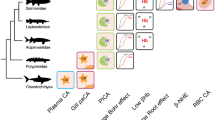Abstract
The gills of three species of Branchipolynoe have been studied in order to better understand the morphological and anatomical adaptations of their respiratory system. These Polynoidae live commensally inside the pallial cavity of different species of Bathymodiolus (Mytilidae), found clustered near deep-sea hydrothermal vents and cold seeps, and which harbor chemolithoautotrophic bacteria in their gills. As the mussels exploit hydrothermal fluid, the pallial cavity is perfused with a sulfide-rich hydrothermal water. The gills of Branchipolynoe species are well-developed branched outgrows of the body wall, located on the parapodia, and filled with coelomic fluid. They do not contain blood vessels. Living animals are red, due to the presence of extracellular hemoglobins in the coelom. The gill epidermis is made of supporting cells and a few ciliated cells arranged in longitudinal rows along the branches. Myoepithelial and ciliated cells line the interior of the coelomic cavity which contains the respiratory pigments. Coelomic fluid circulation inside the gills and body cavity is probably facilitated by both the cilia and myoepithelial contractions. The cuticle, the epidermis, and the coelomic epithelium are completely devoid of bacteria. The gill surface areas per unit body weight and the minimum diffusion distances, between external milieu and coelomic hemoglobins, have been calculated and compared with data already obtained on vascular gills of littoral or hydrothermal species of Polychaeta. In Branchipolynoe species, the respiratory surface area is very large, similar to that of a free-living hydrothermal species Alvinella pompejana, and the minimum diffusion distance is short, similar to that of the littoral species Arenicola marina. Although the organization of these coelomic gills in Branchipolynoe species is totally different from that of usual vascular gills, their characteristics represent a unique and effective respiratory system in Polynoidae which has adapted to the hypoxic and sulfide-rich micro-habitat which probably holds in the mantle cavity of vent mussels. In the gill epidermis, numerous secondary and large compound lysosomes are present which might be involved in sulfide detoxification.
Similar content being viewed by others
Author information
Authors and Affiliations
Additional information
Accepted: 5 August 1998
Rights and permissions
About this article
Cite this article
Hourdez, S., Jouin-Toulmond, C. Functional anatomy of the respiratory system of Branchipolynoe species (Polychaeta, Polynoidae), commensal with Bathymodiolus species (Bivalvia, Mytilidae) from deep-sea hydrothermal vents. Zoomorphology 118, 225–233 (1998). https://doi.org/10.1007/s004350050071
Issue Date:
DOI: https://doi.org/10.1007/s004350050071




